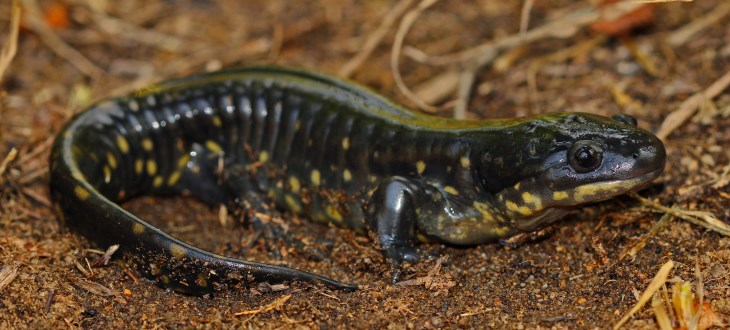The State We're In
Leading the spring parade
“Along the river, over the hills, in the ground, in the sky, spring work is going on with joyful enthusiasm, new life, new beauty, unfolding, unrolling in glorious exuberant extravagance – new birds in their nests, new winged creatures in the air, and new leaves, new flowers spreading, shining, rejoicing everywhere.”
-John Muir, naturalist and author
Nature’s great spring outburst, poetically described in John Muir’s 1869 journal, is still weeks away in New Jersey. But some springtime activities have already begun!
For example, bald eagles are sitting on eggs, and mottled maroon skunk cabbages are pushing up in wetlands. And two of New Jersey’s endangered species – Eastern tiger salamanders and broom crowberry plants – have gotten their usual jump on the season.
Tiger salamanders are the state’s earliest-breeding native animal, and broom crowberries are the state’s earliest blooming native plant.
Prehistoric-looking Easterm tiger salamanders can grow as long as 14 inches. They’re nocturnal and breed on wet nights as early as December, when they crawl out of their underground burrows. Males make their way to ponds and vernal pools, where they gather in the water and wait for females.
“The cold doesn’t bother them as much as you’d think,” said Wayne Russell of Estell Manor, a citizen scientists who has spent years observing tiger salamanders and collecting data on their breeding locations and habits. “They’re even known to walk across snow-covered parking lots to get to the ponds.”
Female tiger salamanders, Wayne noted, are in charge when it comes to mating: “They’re very picky about who they choose. Their mating dance is a real sight to behold.”
Once a female has picked a mate, Wayne said, she will swim under him and bump his neck. That’s a signal for him to release sperm into the water. The female will then absorb the sperm, later releasing five to eight golf ball-sized masses of eggs.
Eggs laid in vernal pools – that is, ponds that dry up in summer – have the best odds of hatching, since these ponds don’t have fish that would otherwise eat the eggs.
Tiger salamander eggs hatch from late March through April, as water temperatures warm. The tadpole-like larvae grow legs in 75 to 118 days, depending on temperature and weather. Most young salamanders emerge from ponds in July and move underground, where they spend most of their lives.
Tiger salamanders were once found from Burlington and Ocean counties southward in New Jersey; however, these endangered animals are now found only in Cape May, Cumberland and Atlantic counties. They start breeding at age three, and always return to the same ponds where they hatched.
“It’s a thrill to see them,” said Wayne, who shares his data with state and federal endangered species agencies to ensure that tiger salamander breeding habitat is protected.
While most New Jersey native plants are waiting for longer and warmer days to flower, the rare broom crowberry (Corema conradii) is starting to bloom now.
A ground-hugging, bushy plant (“Corema” means broom) with tiny purplish-red flowers and needle-like leaves, broom crowberry is found only in a very few spots in the northeastern U.S. and Canada.
Broom crowberry is considered endangered in New Jersey and grows only in the Pine Barrens – mostly in the globally-unique pine plains forest, also known as the “pygmy pines.” Broom crowberry needs open, sandy areas, and depends on wildfires.
The New Jersey Department of Environmental Protection is working to restore broom crowberry habitat in the Stafford Forge Wildlife Management Area in Ocean County. In 2018, the department began bulldozing “scrapes” on the surface of the soil next to broom crowberry populations, creating the conditions they need to expand.
“Broom crowberry seeds typically disperse only within a short distance, so the scrapes must be placed within several feet of existing populations,” explained Bob Cartica, administrator of the NJDEP’s Office of Natural Lands Management. “The seeds are thought to be dispersed by ants, a process known as myrmecochory, which could explain the short dispersal range.”
Like holly trees, broom crowberries are “dioecious,” meaning plants are either male or female. In order for broom crowberries to flower and fruit, the wind must blow pollen from male plants onto female plants.
Spring never fails to delight, so be sure to get outside and explore! And if you love nature, consider becoming a citizen scientist with the state or a local conservation group. This important work helps ensure that rare species like Eastern tiger salamanders and broom crowberries will be around for future generations to enjoy!
To learn more about Eastern tiger salamanders, go to https://www.state.nj.us/dep/fgw/ensp/pdf/end-thrtened/easttgrsal.pdf. To learn about broom crowberries, go to http://www.npsnj.org/photo_galleries/photo_pages/corema_conradii.html.
And to learn more about preserving New Jersey’s land and natural resources, visit the New Jersey Conservation Foundation website at www.njconservation.org or contact me at info@njconservation.org.
About the Authors
Alison Mitchell
Co-Executive Director
John S. Watson, Jr.
Co-Executive Director
Tom Gilbert
Co-Executive Director, 2022-2023
Michele S. Byers
Executive Director, 1999-2021
View their full bios here.
Filter
Get The Latest News
From The Garden State
In the
News

